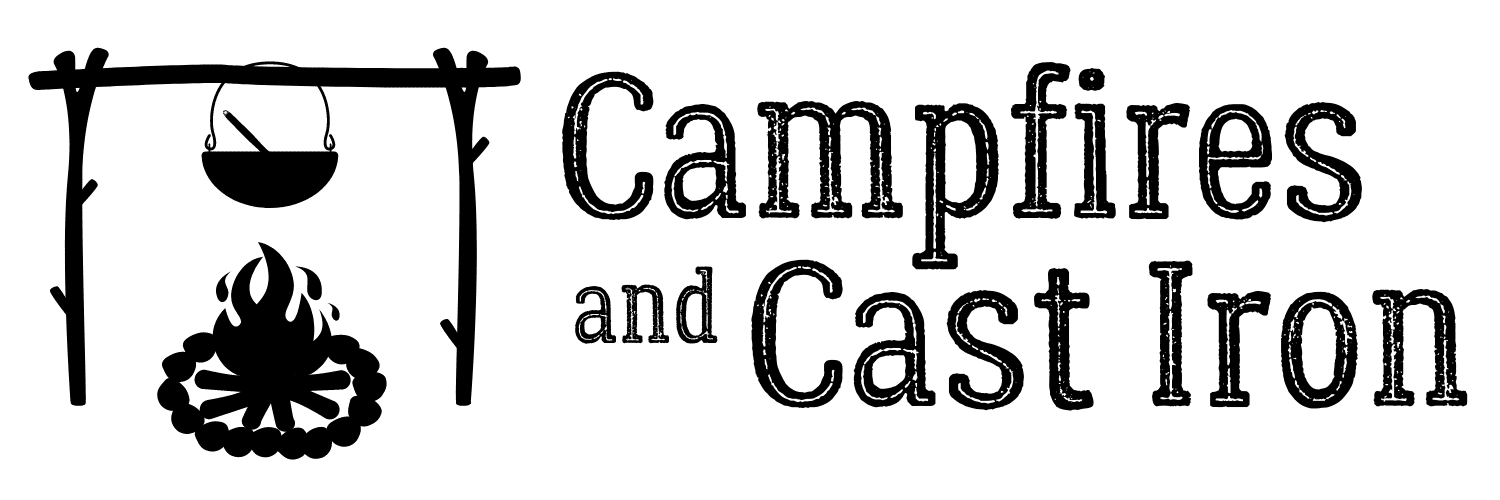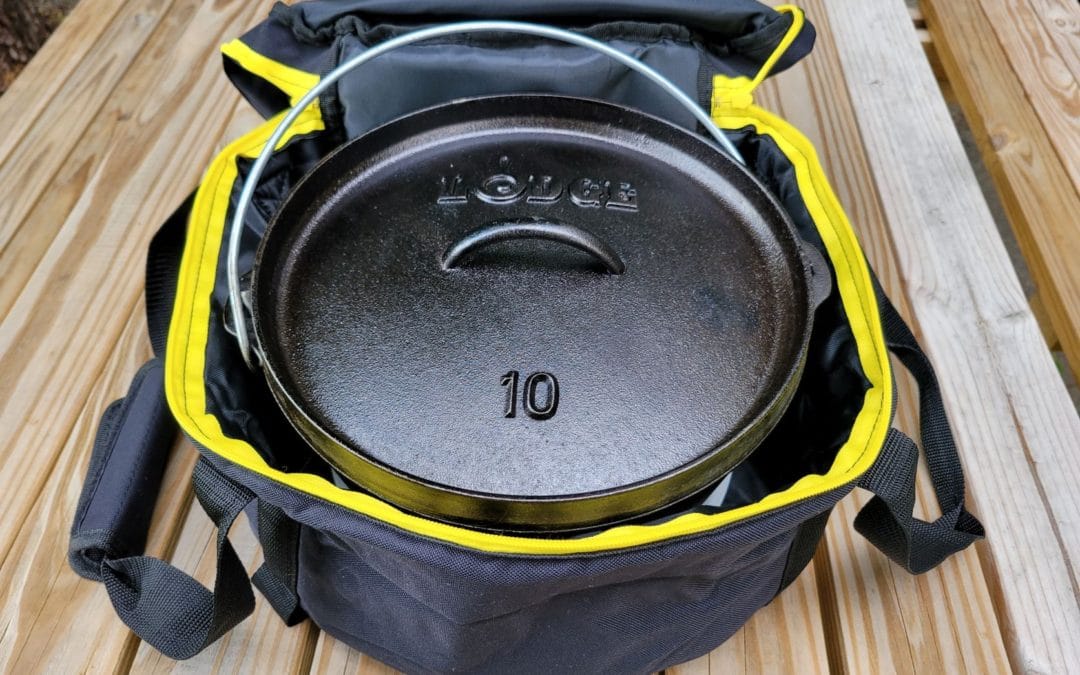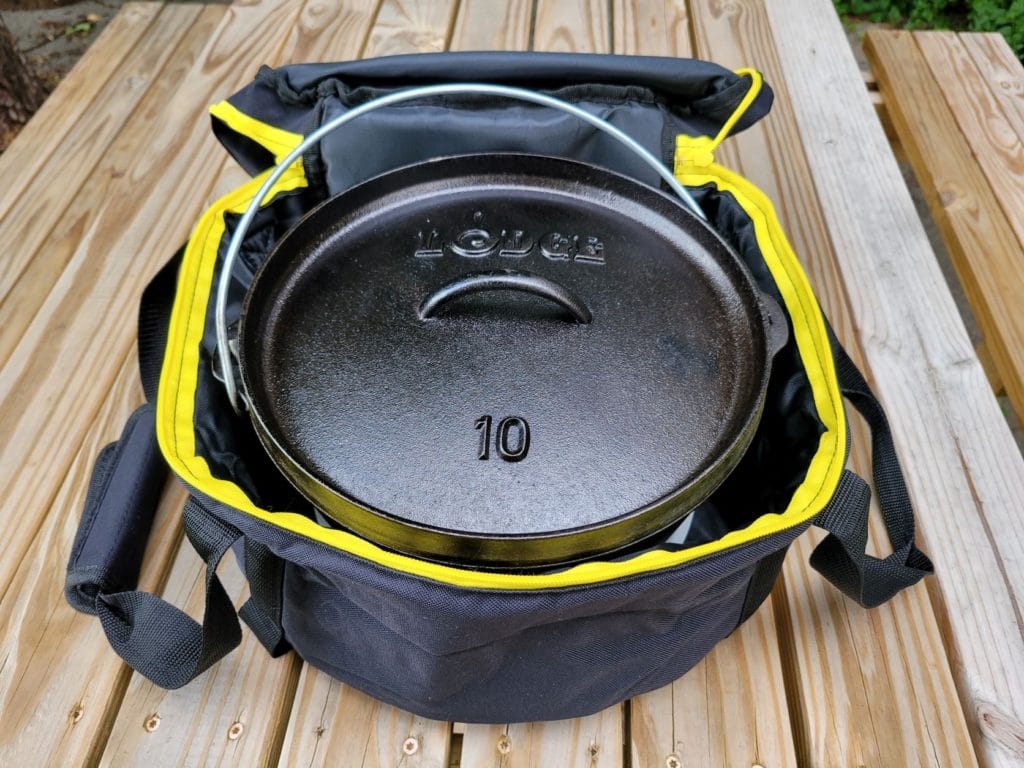Last updated on August 23rd, 2022
Cast iron cookware is one of the most popular and widely used camp kitchen essentials. After all, food cooked outside in a cast iron skillet or dutch oven just tastes so good! But cast iron is heavy, bulky, prone to rust, and can be difficult to transport. So, what’s the best way to safely and conveniently pack cast iron cookware for camping?
Safely pack cast iron cookware for camping by using a protective dutch oven or skillet carrying bag, wrapping pans in old, clean towels or pillowcases, or by placing pans in brown paper bags with layers of paper towels between each piece to avoid scratching and rusting. Then, place cookware in wooden or plastic tote boxes for easy storage and transport.
To help you get the most out of your camp cooking experience, let’s take a more detailed look at how to make packing and transporting your cookware from your vehicle to the campsite as easy as possible. We’ll also look at how to decide which cast iron pans to bring camping and how to properly store your cookware during and after your camping trip to avoid damage and rust.
Which Pieces Of Cast Iron Cookware Should I Take Camping?
When deciding which pieces of cast iron cookware to bring along on your camping trip, consider the following:
- How much room do you have in your vehicle, camper, or RV to transport large cooking items?
- Cast iron cookware is heavy. How far will you need to carry it to and around your campsite?
- What type of meals will you be cooking?
- How many people will you be cooking for at one time?
Cast iron cookware works best for car camping where you will be parked fairly close to your campsite, or if you’ll be staying in a camper or RV. If you will be hiking a long distance to your campsite, have storage space or weight limits, or you’re primarily backpacking or lightweight camping with minimal gear, there are lighter, more portable cookware options available to better suit your needs.
What Types Of Meals Will You Be Cooking?
The type of meals you plan to cook will also determine which cast iron pieces you should take camping. If you’ll be preparing bacon and eggs in a skillet for breakfast and you plan to cook other meals on a grill or in foil packets around the campfire, a single skillet should work just fine. If you will be cooking a mountain man breakfast, simmering a soup or stew, baking cinnamon rolls or bread, or you plan to prepare a roast or whole chicken, you’ll want to bring your dutch oven along.
It’s also important to note that dutch ovens can be used to fry, sear, brown ground meat, and cook bacon and eggs in place of a skillet. Additionally, many dutch oven lids can also be inverted, placed on a stand, and used as a griddle.


How Many People Will You Be Cooking For?
Lastly, the number of people you will be cooking for will help determine the type and size of cast iron cookware you’ll need to bring with you. If it’s a couple’s camping weekend and you’ll only be cooking for two, an 8-inch dutch oven would provide plenty of cooking room. For a family of four, either the 10-inch or 12-inch dutch oven size would be recommended, depending on the appetites of each family member. If you’ll be cooking for a large group of eight or more people, a 14 or 16-inch dutch oven would be the best option to allow for second helpings and leftovers.
When deciding which cast iron skillet to take camping, consider the 10 or 12-inch size. These are the most versatile and portable. A 10-inch skillet is a very practical size for serving two to three people. For four or more people, I typically recommend the 12-inch size.
While cast iron skillets are made in much bigger sizes, I don’t usually recommend cooking at camp with them. The larger surface area tends to produce uneven heat and they don’t fit well on camp stoves and grills.
I’ve created this chart to help you determine which size dutch oven you’ll need. It is based on the capacity of food each one holds and the estimated number of people you’ll be serving. For more information on choosing the best dutch oven size, check out my article, What Size Dutch Oven Do I Need For Camping? How To Decide.
Dutch Oven Capacity And Servings Chart
| Dutch Oven Size | Capacity – Quarts | Capacity – Cups | Serves |
|---|---|---|---|
| 8-Inch | 2 Quarts | 8 Cups | 2-4 People |
| 10-Inch | 4 Quarts | 16 Cups | 4-6 People |
| 10-Inch Deep | 5 Quarts | 20 Cups | 5-7 People |
| 12-Inch | 6 Quarts | 24 Cups | 6-8 People |
| 12-Inch Deep | 8 Quarts | 32 Cups | 8-10 People |
| 14-Inch | 8 Quarts | 32 Cups | 8-10 People |
| 14-Inch Deep | 10 Quarts | 40 Cups | 10-12 People |
| 16-Inch | 12 Quarts | 48 Cups | 12-16 People |
How To Pack Cast Iron Cookware And Store It At Camp
After deciding which pieces of cast iron cookware you will be bringing on your camping trip, you’ll want to make sure to pack them carefully. This will help avoid damage to pans and surrounding items. It also makes transporting them to your campsite as easy as possible.
While you’re at camp, you’ll also want to protect your pans from rust-causing rain, dew, and humidity when they’re not in use. Let’s take a look at several good options for packing and storing cast iron cookware while camping.
Dutch Oven And Skillet Tote Bags
One of my favorite ways to pack and transport my cast iron pans is with a dutch oven or skillet tote bag. These bags are specially designed with padding and reinforced handles to make protecting and carrying your cookware much easier. You can also store your dutch oven and skillet in these tote bags between uses while camping to protect them from the elements.
When using a dutch oven tote bag, I prefer to use the next size up so it will hold both my dutch oven and a similarly-sized skillet inside the bag and still zip closed. For example, my dutch oven is a 10-inch model. I opted to get the 12-inch sized tote bag and it comfortably holds the dutch oven with my 12-inch skillet stacked on top.

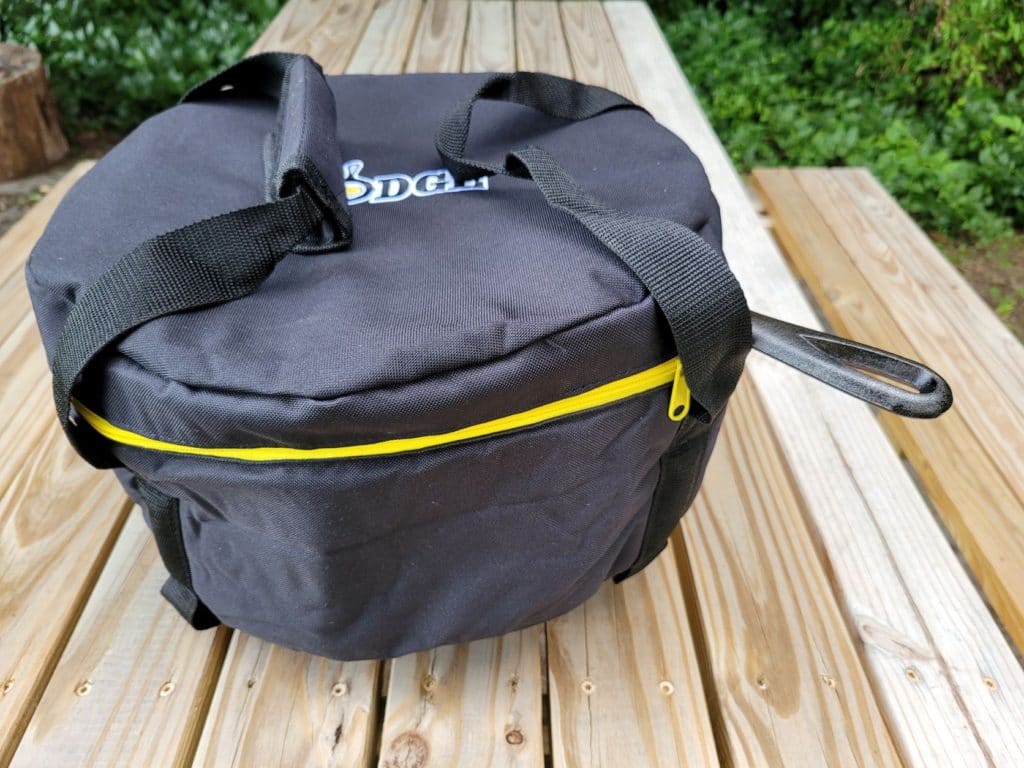
An additional tip I’ve found that works well is to place a cheap but sturdy metal pie plate or pizza pan in the bottom of the dutch oven tote bag. A circular wooden cutout or layers of cardboard work well, too. This provides added strength and stability to the bottom of the bag and prevents the legs of the camp dutch oven from wearing through the material. In the same way, it’s also possible to remove the dutch oven lid, place it in the bottom of the bag, and stack the oven on top.

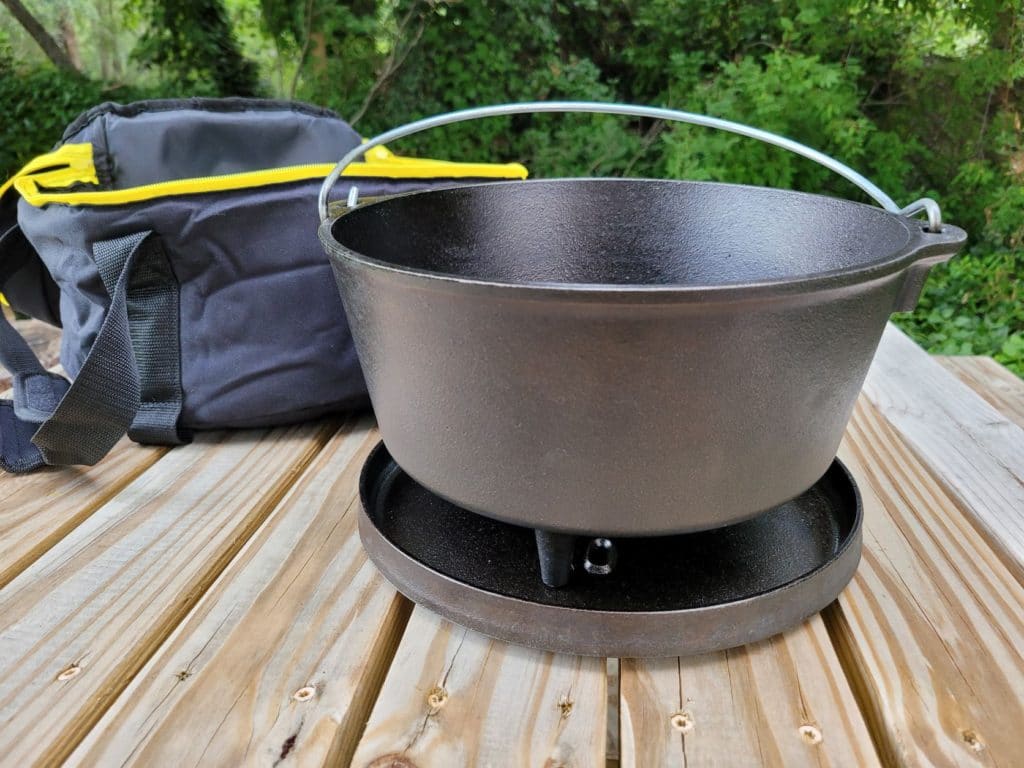
Wrap Cookware In Protective Materials
A cheap and easy way to protect your cast iron cookware during transport is to simply wrap each piece in an old, clean towel or pillowcase, or even in brown paper shopping bags. This not only protects the pans but also reduces the chances of the cast iron cookware scratching or damaging other items in your vehicle while driving to camp.
Cast Iron Cookware Storage and Transport Boxes
Dutch ovens and skillets can also be placed in sturdy boxes or tote containers to make carrying and storing them easier. The two containers I’ve had the most success with are milk crates and plastic tote boxes with a lid.
When using a milk crate, I always line the bottom with a metal baking pan or wooden cutout to keep the legs of the camp dutch oven from falling through. I place a couple of paper towels or a clean dishcloth between stacked pans to avoid scratching and store the cookware in an area where it won’t get wet from rain or dew.
A plastic tote box with a lid is an even better way to transport and store camp cookware, as it will shield items from dirt and moisture. Many plastic totes also have wheels, which makes moving cast iron cookware from the vehicle to the campsite even easier, especially when bringing multiple pieces or cooking for a large group. As with the crate, make sure to place paper towels or clean dishcloths between stacked pans to avoid scratching or damaging the seasoning.
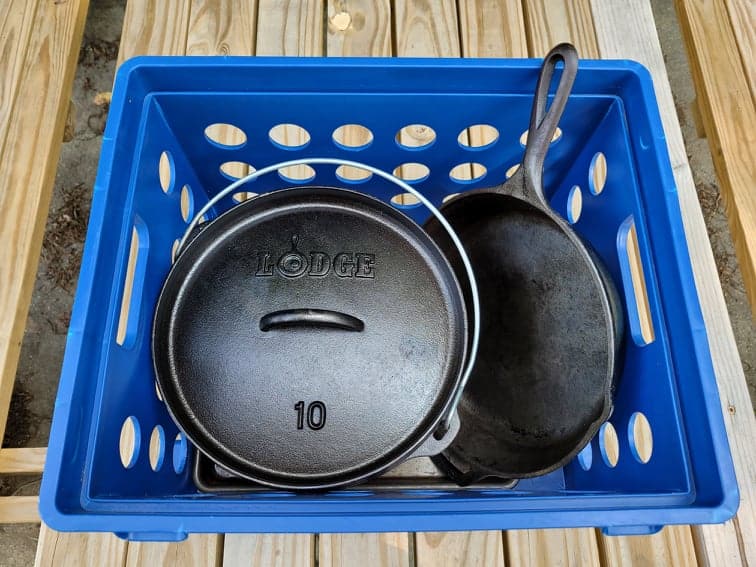

How To Store Cast Iron Cookware After Camping
After returning from a fun camping trip filled with lots of delicious campfire cooking, you’ll want to make sure your cast iron cookware is properly cleaned, stored, and ready for next time by following these guidelines:
- Make sure each cast iron piece is completely clean and dry. Re-season pans if needed, or wipe them down with a very light coating of oil to protect the iron from moisture and oxidation.
- Store cookware in a cabinet, on the stovetop, on a hanging rack, or in a box or storage bag. Store dutch ovens and skillets with the lids off. This will allow air to circulate and decrease the chances of rusting. This cast iron storage tower is my personal favorite. I have several pieces of cookware on mine and it has held up well.
- Always store cast iron away from sources of moisture. For example, don’t stack skillets in a cabinet next to the sink or dishwasher.
- Be cautious about storing cast iron cookware in campers, storage units, or in tote boxes outdoors. Humidity contributes to rust.
Now that you know how to properly pack cast iron cookware for camping, it’s time to get outdoors and cook some amazing campfire meals! Be sure to check out the Recipes section of the blog for delicious traditional and allergy-friendly camping recipes.
This post may contain affiliate links. This means if you click on a link and make a purchase, I will receive a small commission, at no cost to you, that makes it possible for me to keep the Campfires and Cast Iron site up and running. Please see our disclosure policy for details.
